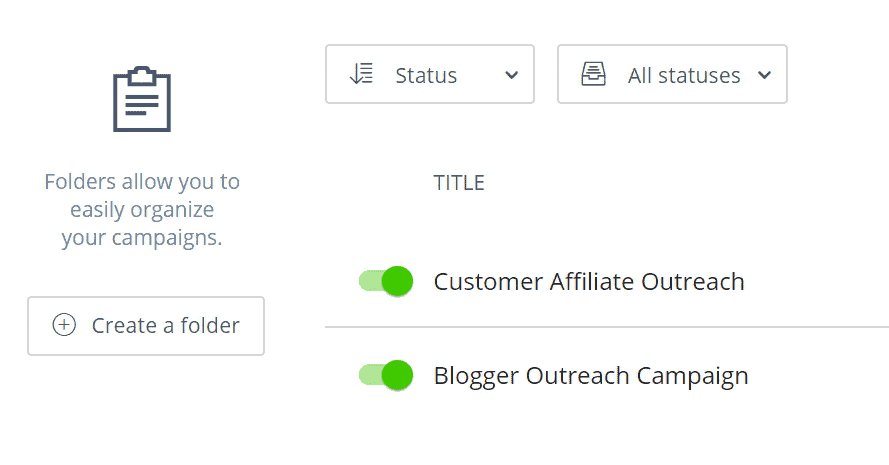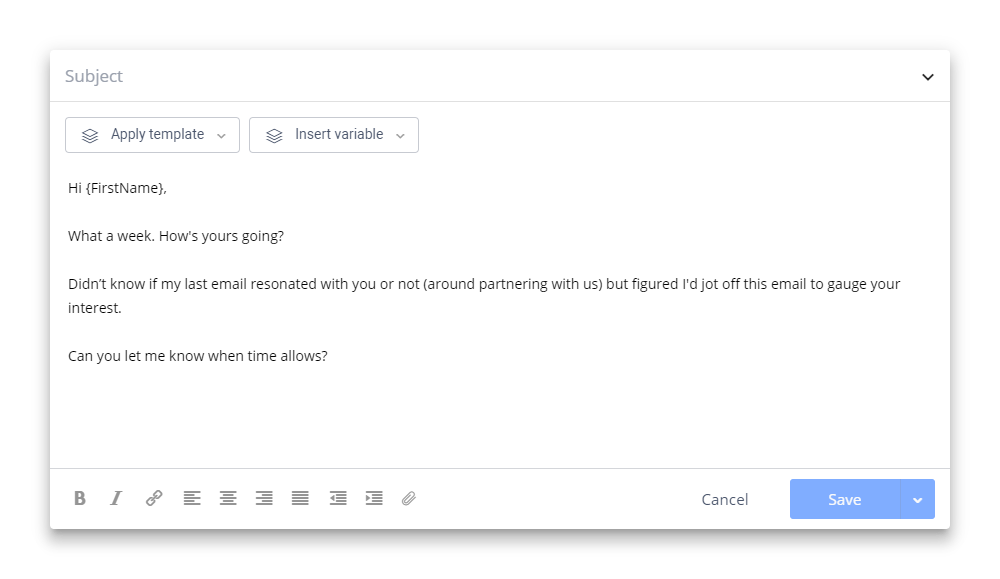If you are a Software-as-A-Service company, no matter what industry you are in, there is a good chance you have an affiliate program.
And in most cases when your affiliate program is starting out, you are very reactive with it, letting affiliates signup on their own if they are interested.
This is fine and dandy until you meet a crossroad where your affiliate program has the potential to be a channel of growth for your company and bring in quality customers through qualified affiliate partners.
But how do you successfully pitch these qualified affiliate partners?
Today, I am going to go over my ways for pitching SaaS Affiliates to get them on board to promote a company’s products and services through their affiliate program.
In this post you’ll learn about:
Finding the right affiliate partners
I am going to be completely honest. Finding the RIGHT affiliate partners can be hard work.
There is no shortcut on this; it takes time, energy, and lots of searching to get a good mix of partners that would be a right for your program.
Luckily, you can get a jump start on where to go to find affiliates for your SaaS company, here: Finding Affiliates to Promote your SaaS Company | Up Foundry Resources. Take a read and then head back over here on how to pitch them.
Define Pitch Segments/Audiences
Now that we have a good idea on where to find SaaS affiliates, for the purpose of this post, we are going to be focusing in on just two types:
- Your current customers (self-explanatory)
- Bloggers or Mid-level Publishers (sites who rank well in your niche or have some overall coverage)
As you can see, the term “affiliate” doesn’t refer to one type of business or person because affiliate is a model: You pay someone or entity a commission for bringing you a qualified customer.
The next step is to setup campaigns per audience type.

Setup Campaigns & Initial Pitch Copy
If you are using Reply.io, you can set these up in a flash.
Current Customers:
For your current customers, audience segment, I would write something like this:
The point here is: your customers have a wide range of talents, backgrounds, and do all different things. This email is meant to qualify:
a) who is a good fit and
b) who is geared to work together for a long-term affiliate SaaS partnership.
Note:* I just didn’t say, “join our affiliate program!” That is not really a good pitch because although the benefit for them would be obvious (commissions) – they might need someone like you to realize the value of it. and work with them to make their goals come true.
Bloggers and Mid-Level Publishers:
With bloggers, it needs to be highly personalized and you need to research their website and how they position other products and services they refer their audience to.
I like to talk about how my product/service would be a fit for their audience (“and here’s why…” as well as the benefits of a long-term relationship working together (providing exclusive opportunities, discounts, bonuses, and other perks).
For the first email, I like to follow the AIDIA email format. What does AIDA stand for?
- Attention – Something that visually catches their eye.
- Interest – A phrase or single sentence that is meant to pique their interest in working together.
- Desire – Shifting their mindset from where they are to where they want to be in the future.
- Action – What action you’d like them to take at the end of the email as a result of you reaching out.
I think most people can come up with bullet points #2-4, however, the attention one can be tough.
In essence, you have to do what is authentic to you and not make it come off as cheesy or desperate. For me, I REALLY love video and making my own animated gifs. It’s just part of my personality.
If you do your “Attention” part right, you end up with responses like this on Twitter from the affiliate prospects; which is a good indicator that they would like to work with you are at least be open to a conversation:
When an email starts with a custom gif just for me, you get a call back. Kudos @TaylorBarr for the best outreach e-mail in awhile. pic.twitter.com/d0DfWl2mL7
— Katrina Kibben (@KatrinaKibben) January 11, 2017
About value propositions and pitches in your emails…
As mentioned earlier, your pitch shouldn’t be – join my affiliate program! Especially for external affiliates (those that are not your customers).
They are first going to need time to test your platform/software, see if they like it, THEN endorse it.
So WHAT should it be?
Check out their website, see how they might be promoting other products and services.
Then – establish what you feel could be the “pay off” for working together as partners. Customizing it per affiliate/publisher is the key to success here.
Follow up and test different variants
If you don’t get a response from your initial, cold email – do not worry! Lack of reply is not necessarily a cause of “not interested.” As we all know: the proof is in the follow up.
For customers, I’d only followup up once, max twice if you know they might be a really good fit for the program.
And follow-ups shouldn’t be:
Just following up on this.
or
Just wanted to bump this up in your inbox.
This is way overused and often is a quick signal in your recipients brand to not respond – more tips on that here.
Rather, use more of a unique style of language in your blogger affiliate template and being genuine to get their attention. Something like:
For your Bloggers/Mid-Level Publishers – since you do not have a relationship with them (i.e. the way you do with your customers) it’s going to take a little more persistence.
I would follow up 2-4 times over the course of 2-3 weeks.
My steps in Reply.io might look like this:

I would test this with a small level of prospects (going all the way through the steps) and see response rates.
If you are seeing open rates on them but no response – run variants on the steps to see where you can improve. You might even add new elements such as a digital pitch or presentation and see if that has some positive effects.
So let’s say you get a few responses, and out of those responses you get some interest to join your affiliate program.
You then send them the link and they join. It means you are done, right?
Nope – just getting started…
Affiliate Signups & Onboarding
Just because they signed up for your affiliate program, doesn’t mean they will promote and show performance. That is why you will need a whole new follow-up sequence for affiliate onboarding to get them engaged to:
1) Start externally promoting your product with affiliate links.
2) Continue to promote, given their resources and time.
So what kind of incentives can you offer to spark this type of behavior?
- First Sale Bonus – They say the hardest task is going from 0 to 1. Same is true for some affiliate partners going from zero sales to one and beyond. Give them a small cash bonus or gift card for hitting their first sale/referred customer.
- Provide Content ideas – Your goal is to make them successful in promoting your products and services, and for them – you are the expert. Give them tips on how to position your platform in reviews, blog posts, email newsletters, webinars, and more.
- Reactivation Incentive – You will almost always get people who sign up but then drop dormant. Create an affiliate campaign to them saying – If you write a review we will do X for you. If you get your first sale in 60 days from being non-active, we will bump your commission rate up to XYZ. Get creative. One more great way of reactivating your affiliates will be to share promo codes and special offers to affiliate marketing tools to help them earn more. For instance, there’s a tool called Voluum designed for affiliate marketers to help them track all their campaign performance in one place. One more tool that affiliate marketers appreciate is Clickmeter. This solution allows tracking the efficiency of affiliate links that you’ve created. Finally, you can partner up with some well-known affiliate marketing communities like Smart Passive Income and get exclusive discounts on their courses for your own affiliates.
Overall, you want to keep them engaged and constantly be showing them ways they can get to the Desire phase (the one you mentioned in your AIDA first outreach email, earlier in this post).
Wrapping it up…
Finding and recruiting affiliate partners for your affiliate program takes time, creativity, and persistence.
But it pays off.
Affiliate program economics are 90/10.
90% of your sales and revenues come from just 10% of your partners (similar to the Pareto Principle with the 80/20 rule).
Therefore, all it takes is just a few affiliate partners to create massive traction in your affiliate program.
![How to Pitch & Recruit SaaS Affiliates for Your Affiliate Program [Guide] How to Pitch & Recruit SaaS Affiliates for Your Affiliate Program [Guide]](https://reply.io/wp-content/uploads/affiliates-1080x567.jpg)



![New in 2025: Reply.io Teams Up with Persana AI [+Live Webinar] New in 2025: Reply.io Teams Up with Persana AI [+Live Webinar]](https://reply.io/wp-content/uploads/persana.io_-1024x538.jpg)


